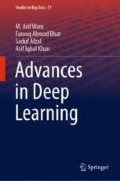Abstract
The cascade of multiple layers of a deep learning architecture can be learnt in an unsupervised manner for the tasks like pattern analysis. A deep learning architecture can be trained one layer at a time, treating each layer in turn as an unsupervised restricted Boltzmann machine. Unsupervised deep learning algorithms are important because unlabeled data is more abundant than the labeled data. For applications with large volumes of unlabeled data, a two-step procedure is used: in the first step, a deep neural network is pretrained in an unsupervised manner; in the second step, a small portion of the unlabeled data is manually labeled, and then used for supervised fine-tuning of the deep neural network.
Access this chapter
Tax calculation will be finalised at checkout
Purchases are for personal use only
Bibliography
Afzal, S., Wani, M.A.: Improving performance of deep networks on handwritten digit classification. In: 2017 4th International Conference on Computing for Sustainable Global Development (INDIACOM), pp. 4238–4241. IEEE (2017)
Afzal, S., Wani, M.A.: Deep neural network architectures: a review. In: 2018 5th International Conference on Computing for Sustainable Global Development (INDIACOM), pp. 3024–3030. IEEE (2018)
Afzal, S., Wani, M.A.: Training and model structure of deep architectures. Artif. Intell. Syst. Mach. Learn. 10(2), 38–46 (2018)
Bengio, Y.: Learning deep architectures for AI. Found. Trends® Mach. Learn. 2(1), 1–127 (2009)
Bengio, Y., Courville, A., Vincent, P.: Representation learning: a review and new perspectives. IEEE Trans. Pattern Anal. Mach. Intell. 35(8), 1798–1828 (2013)
Bengio, Y., Lamblin, P., Popovici, D., Larochelle, H.: Greedy layer-wise training of deep networks. In Advances in neural information processing systems, pp. 153–160 (2007)
Erhan, D., Bengio, Y., Courville, A., Manzagol, P.A., Vincent, P., Bengio, S.: Why does unsupervised pre-training help deep learning?. J. Mach. Learn. Res. 11(Feb), 625–660 (2010)
Goroshin, R., LeCun, Y.: Saturating auto-encoders. arXiv preprint arXiv:1301.3577 (2013)
Hinton, G.E.: Training products of experts by minimizing contrastive divergence. Neural Comput. 14(8), 1771–1800 (2002)
Hinton, G.E., Salakhutdinov, R.R.: Reducing the dimensionality of data with neural networks. Science 313(5786), 504–507 (2006)
Hinton, G.E., Osindero, S., Teh, Y.W.: A fast learning algorithm for deep belief nets. Neural Comput. 18(7), 1527–1554 (2006)
Larochelle, H., Bengio, Y., Louradour, J., Lamblin, P.: Exploring strategies for training deep neural networks. J. Mach. Learn. Res. 10(Jan), 1–40 (2009)
Lee, H., Ekanadham, C., Ng, A.Y.: Sparse deep belief net model for visual area V2. In: Advances in Neural Information Processing Systems, pp. 873–880 (2008)
Poultney, C., Chopra, S., Cun, Y.L.: Efficient learning of sparse representations with an energy-based model. In: Advances in Neural Information Processing Systems, pp. 1137–1144 (2007)
Rifai, S., Vincent, P., Muller, X., Glorot, X., & Bengio, Y.: Contractive auto-encoders: explicit invariance during feature extraction. In: Proceedings of the 28th International Conference on International Conference on Machine Learning, pp. 833–840. Omnipress (2011)
Tieleman, T., Hinton, G.: Using fast weights to improve persistent contrastive divergence. In: Proceedings of the 26th Annual International Conference on Machine Learning, pp. 1033–1040. ACM (2009)
Vincent, P., Larochelle, H., Bengio, Y., Manzagol, P. A. Extracting and composing robust features with denoising autoencoders. In: Proceedings of the 25th international conference on Machine learning, pp. 1096–1103. ACM (2008)
Vincent, P., Larochelle, H., Lajoie, I., Bengio, Y., Manzagol, P.A.: Stacked denoising autoencoders: Learning useful representations in a deep network with a local denoising criterion. J. Mach. Learn. Res. 11(Dec), 3371–3408 (2010)
Wani, M.A., Afzal, S.: Gain parameter and dropout-based fine tuning of deep networks. Int. J. Intell. Inf. Database Syst. 11(4), 236–254 (2018a)
Wani, M.A., Afzal, S.: Optimization of deep network models through fine tuning. Int. J. Intell. Comput. Cybern. 11(3), 386–403 (2018b)
Author information
Authors and Affiliations
Rights and permissions
Copyright information
© 2020 Springer Nature Singapore Pte Ltd.
About this chapter
Cite this chapter
Wani, M.A., Bhat, F.A., Afzal, S., Khan, A.I. (2020). Unsupervised Deep Learning Architectures. In: Advances in Deep Learning. Studies in Big Data, vol 57. Springer, Singapore. https://doi.org/10.1007/978-981-13-6794-6_5
Download citation
DOI: https://doi.org/10.1007/978-981-13-6794-6_5
Published:
Publisher Name: Springer, Singapore
Print ISBN: 978-981-13-6793-9
Online ISBN: 978-981-13-6794-6
eBook Packages: Intelligent Technologies and RoboticsIntelligent Technologies and Robotics (R0)

